Recent Storm Damage Posts
Hurricane Season 2022
6/1/2022 (Permalink)
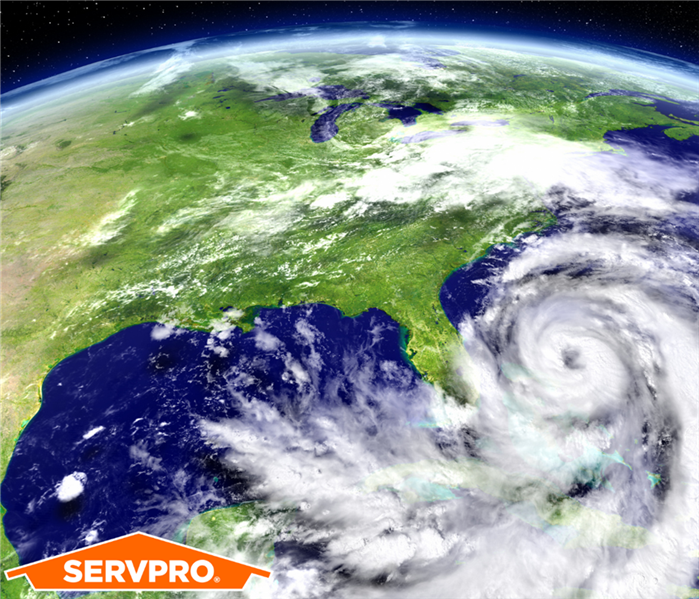 Never underestimate the destructive power of a hurricane.
Never underestimate the destructive power of a hurricane.
Today marks the first day of summer as well as the start of the 2022 hurricane season. While our area doesn’t usually experience hurricanes, the past couple of years have shown that the tail end of some hurricanes can reach us. Suffice it to say, it is always best to be prepared, because even the tail end of a hurricane brings torrential thunderstorms and potential flooding.
First off, forecasters at the National Oceanic and Atmospheric Administration (NOAA) predict that the 2022 hurricane season has a 65% chance of having above-average hurricane activity. This is based on several climate factors, such as the ongoing La Nina and a warmer-than average sea surface temperature in the Atlantic and Caribbean. Also, if we look at the trend over the past several years, we can expect these storms to last longer and hit harder.
We encourage everyone to keep an eye on the weather forecasts this season. We will also be updating our blog on any potential news to keep us all prepared on the latest.
We Mitigate and Repair Damage from Heavy Rainstorms
5/18/2022 (Permalink)
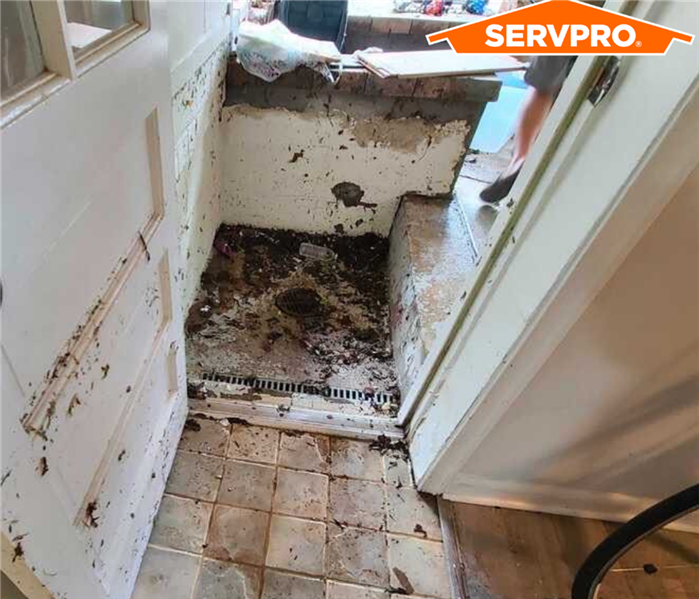 Heavy rainstorms can clog storm drains with debris.
Heavy rainstorms can clog storm drains with debris.
As the Spring season continues, we are starting to see more and more rainstorms pop up. If you’re not prepared, they can cause severe flooding damage. Just like this job we recently received. where a storm drain right outside this family’s basement was clogged by storm debris.
The clog caused a massive amount of water to pour into their basement, completely ruining their wood floors and leaving four-inch-high water line marks on all the walls. Our Mitigation Team had to tear up all the wood floors and make a two-foot-high flood cut in all the drywall to ensure all the moisture in the basement was removed. Our Construction Team then went in and installed brand new wooden floor panels, new drywall and even a new door to their basement bathroom.
While we were able to leave this basement better than it was before the storm, it goes to show how devastating heavy rainstorms can be. You can never be too prepared. And if you find yourself in a similar situation, gives us a call and we will make it “Like it never even happened.”
SERVPRO Has Its Own Meteorologist?
4/15/2022 (Permalink)
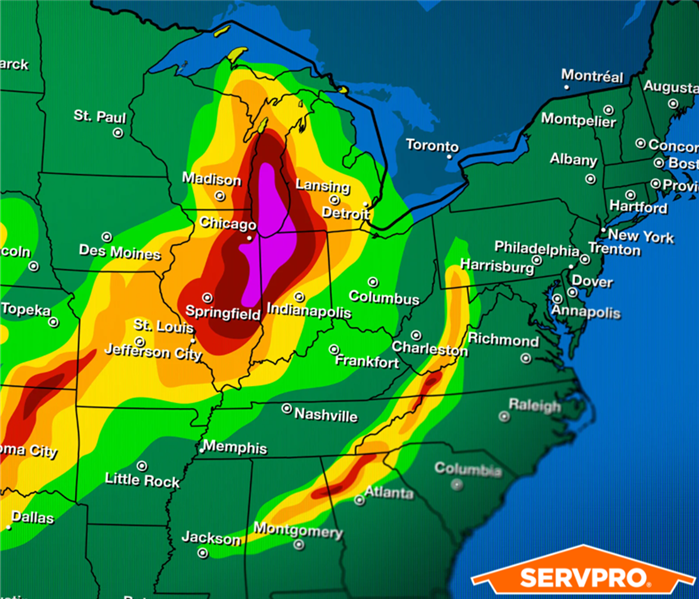 We take storm preparedness very seriously.
We take storm preparedness very seriously.
It might surprise you, but we here at SERVPRO have our own Meteorologist. Storm preparedness is something we take very seriously. It’s not enough to just pay attention to the Weather Channel. We’re not interested in routine showers or overcast days. We want to be able to track huge weather patterns that result in severe storms before they happen. Any leg up we can get on the weather allows our national storm response teams to quickly mobilize where they are needed most.
Every second counts when it comes to storm damage. Our number one goal is to help alleviate the anxiety and pain of those affected by weather disasters. The sooner we can respond to them, the sooner they can get back to living a normal life. Not to mention, the less likely their situation gets worse. Having our meteorologist track last years polar vortex as it was developing, helped save those affected time and money. It’s just another way that we go above and beyond for our customers.
Preparing For Spring Storms
4/11/2022 (Permalink)
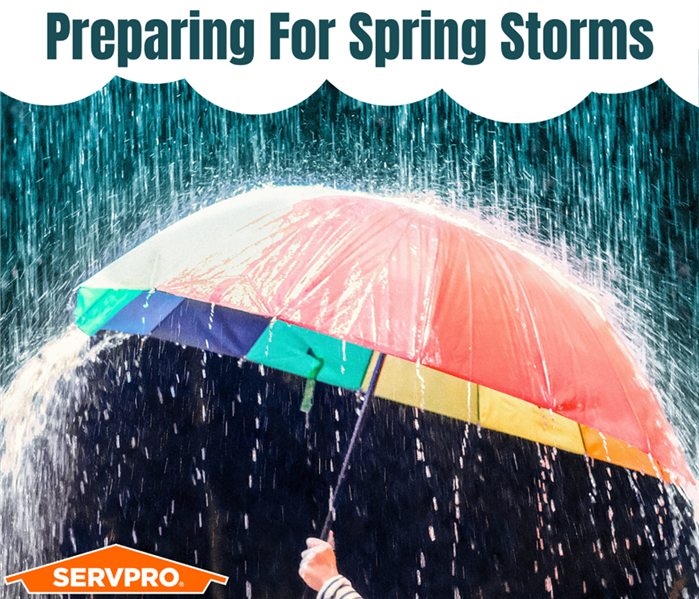 Don't get caught in the rain this Spring!
Don't get caught in the rain this Spring!
Spring is finally upon us! As the cold weather of winter starts to thaw, it’s a good time to start preparing for the climate shift. April showers sound delightful on paper, but they can quickly escalate into torrential downpours or thunderstorms. That is why it is never too late to double check your storm readiness.
First off, everyone should have a general emergency kit in their house and vehicle. These should include a radio, flashlight, extra batteries, a first-aid kit, emergency contact information and non-perishable food. No matter the type of storm, these kits are invaluable to have.
More specific rainstorm advice revolves around potential flooding. Make sure you keep your gutters and storm drains clear of leaves and debris. Try and keep valuables on high shelves when storing materials in your basement or areas that are prone to flood. Always keep rain gear and water-resistant clothing easily accessible in your home and car. Last but not least, never drive through standing water or wade into flooding basements. Both can be fatal.
These simple steps can be lifesavers. It’s important for everyone to take stock and implement them as we enter the rainy season. And if you do experience any flooding this spring, you can always count on us to restore the water damage.
Storm Response Program
3/11/2022 (Permalink)
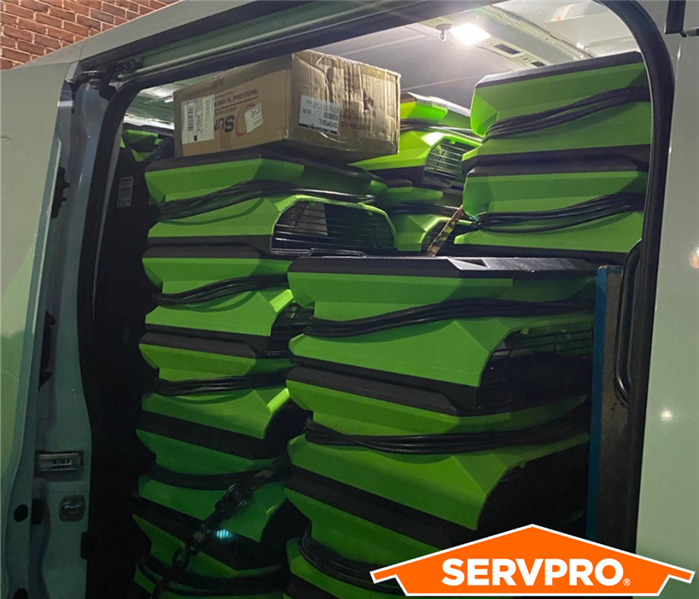 We're fully prepared to go where ever a storm hits!
We're fully prepared to go where ever a storm hits!
Our franchise is extremely proud to be a part of the national SERVPRO Storm Response Program. Our company is built upon the desire to serve those affected by disasters. Be it a small bathroom leak or a category 5 hurricane, we are committed to help restore what is lost. While our first concern is always for those in our immediate community, sometimes the need created by huge national storms is too great to ignore.
Last year, for instance, during the horrible winter freeze in Texas that incapacitated their power grid, we traveled to Irving to help those most in need. Later in September, in the wake of Hurricane Ida’s devastation, we drove up to Philadelphia to start rebuilding the damage. Every second counts during national storm emergencies. Without the Storm Response Program, coordinating these efforts would have taken much longer.
These experiences have shaped us into an even more close and compassionate crew. The gratitude and love we received out in the field have had a deep affect on us and our work even here at home. This is why we will continue to be a proud member of the Storm Response Program.
Tips to Prepare for Winter Storms
2/7/2022 (Permalink)
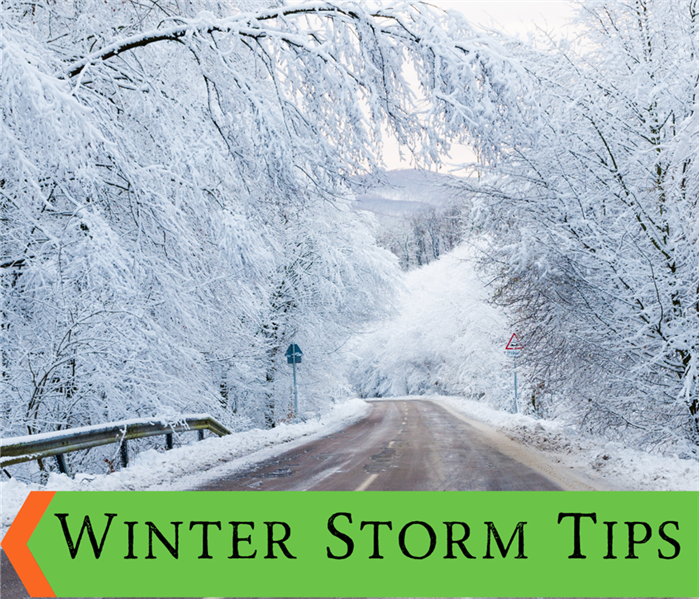 It's never too late to prepare for winter storms.
It's never too late to prepare for winter storms.
The winter storm season is upon us! In fact, we have already endured a couple this year, but it’s never too late to prepare for the next one. Here are some simple tips to keep safe in case you are caught outside during a winter storm.
First off, make sure that whenever you leave the house, you are properly dressed for cold weather, even if you aren’t planning to be outside for long. This may seem obvious, but in the event that a storm strands you outdoors, its crucial to be bundled up. For extreme cold, its recommended to wear 2-3 layers of clothes, 1-2 pant layers, a warm hat, gloves, waterproof boots, and a face covering like a scarf.
If you plan to be driving in extreme cold weather, you should keep your gas tank at least half full. This will allow you to keep your vehicle’s heat on longer in the event you get stuck out on the open road. It’s also important to keep a winter survival kit in your car. Alongside year-long necessities like jumper cables, working flashlights, a First-Aid kit, non-perishable foods like nuts and energy bars, water bottles, and a phone charger, you should also store some blankets, a shovel for snow, and an ice scraper.
Of course, these tips also apply if your house loses electricity, and you are snowed in. However, it’s important to remember in that situation to never use gas stoves to try and keep warm. The risk of a house fire is too great. Also, if you have a generator, make sure it is properly ventilated to avoid any carbon monoxide poisoning.
Hopefully, these tips can help you brave the next winter storm. It always pays to be prepared!
One Landscaping Trick to Limit Storm Damage in Marlton/Morningside
6/3/2021 (Permalink)
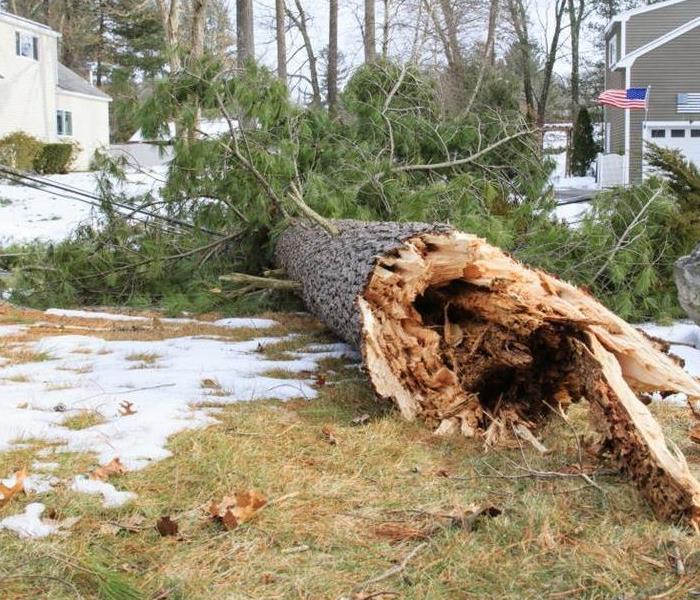 Here you can see just how dangerous trees can be and how they exacerbate storm damage
Here you can see just how dangerous trees can be and how they exacerbate storm damage
Storm damage is often unexpected and incredibly inconvenient. While no one can control the weather there is one very easy "trick" you can do to help limit the amount of damage a storm may cause! Below we will explore how pruning can prevent storm damage and some best practices to follow while pruning!
Pruning limits the amount of debris a potential storm can blow into your property as well as gives you a chance to inspect a tree for health and potential hazards.
Before and while pruning, make sure to look for these signs of a potential hazard:
- Cracks in the trunk or major limbs.
- Hollow trunk (or mushrooms growing from the bark, indicating decay)
- Heavy leaning to one side or the other
- Branches hanging over the house near the roof.
- Limbs touching live power lines.
- V-shaped forks rather than U-shaped ones. V-shaped are more likely to split.
- Branches that cross and interfere with each other.
These are signs that the tree may pose a greater threat to your residential or commercial structure and may need to be cut down.
Now, while pruning it is important to:
- Avoid pruning branches that are flush with the trunk. This could expose trunk wood, opening the tree up to possible decay or insect damage.
- Begin by making a cut partway through the bottom of any limb to be trimmed, a few inches from the trunk. Then cut through the limb just above the first cut. This ensures that when the limb falls, it will not tear a long strip of bark on the way down.
- Finish by cutting off the few inches sticking out from the trunk. Leave the “branch collar,” the swollen area of trunk tissue that forms around the base of a branch. Keeping the branch collar protects the main trunk from damage.
After a storm, prune a tree just enough to balance the loss of roots. Cut out broken, diseased and malformed branches to give the tree a desirable shape. Continue to care for them to help them get healthy again.
Following these pruning tips will help limit storm damage, however, nothing can eliminate the threat of storm damage completely! If your residential or commercial building has suffered any storm damage give us a call here at SERVPRO of Marlton/Morningside at (301) 856-5402 and we will handle the mess quickly, professionally, and with great customer service!
How Thunderstorms Cause Storm Damage in the Marlton/Morningside Area
6/3/2021 (Permalink)
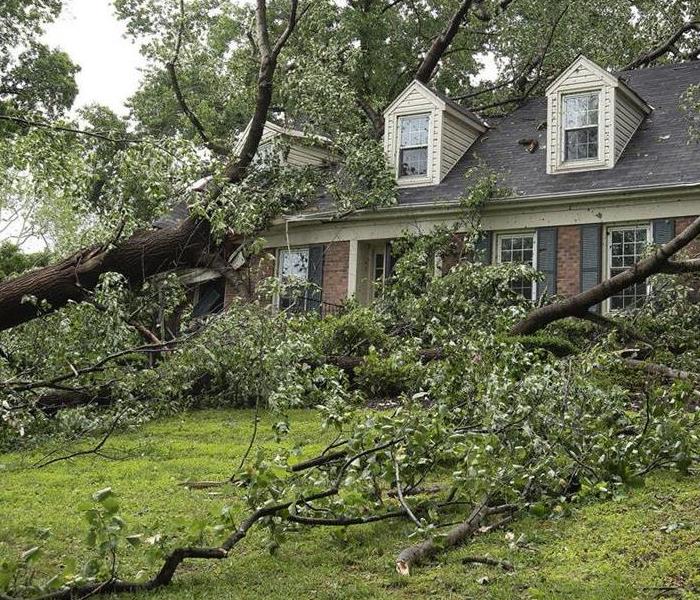 The aftermath of a serious thunderstorm
The aftermath of a serious thunderstorm
Many people think only tornadoes, hurricanes and other extreme weather conditions can cause storm damage but that isn't the case. Yes, while the more extreme weather patterns can cause very devastating storm damage, a sever thunderstorm can be quite destructive as well. In this article we'll explore exactly what kinds of damage a thunderstorms can cause.
Flooding
In addition to the thunder and lightning, people generally associate with thunderstorms, you can't forget that a thunderstorm is still a storm, meaning there is potential for flooding due to excess rainfall. In fact, under the right conditions, rainfall from thunderstorms can cause flash flooding, killing more people each year than hurricanes, tornadoes or lightning.
Lightning
Lightning is responsible for many fires around the world each year, and causes fatalities property damage.
Hail
While technically a hail storm is different from a thunderstorm, it can be the case that the two coincide and hail starts to fall during a thunderstom. Hail can get up to the size of softballs damaging windows, roofs and doors on most residential and commercial buildings.
Wind Damage
Thunder storm winds, called straight-line winds which travel up to 120 mph can knock down trees, associated with thunderstorms knock down trees, power lines and mobile homes, causing serious damage to surrounding homes and buildings.
Now, luckily, the most sever thunder storms generally happen more south in states like Texas, however, even in the Marlton/Morningside area it isn't impossible for us to see serious storm conditions that result in storm damage. If you ever find yourself in need of storm damage restoration services call us here at SERVPRO of Marlton/Morningside at (301) 856-5402.
The Most Common Types of Storm Damage in the Marlton/Morningside Area
6/3/2021 (Permalink)
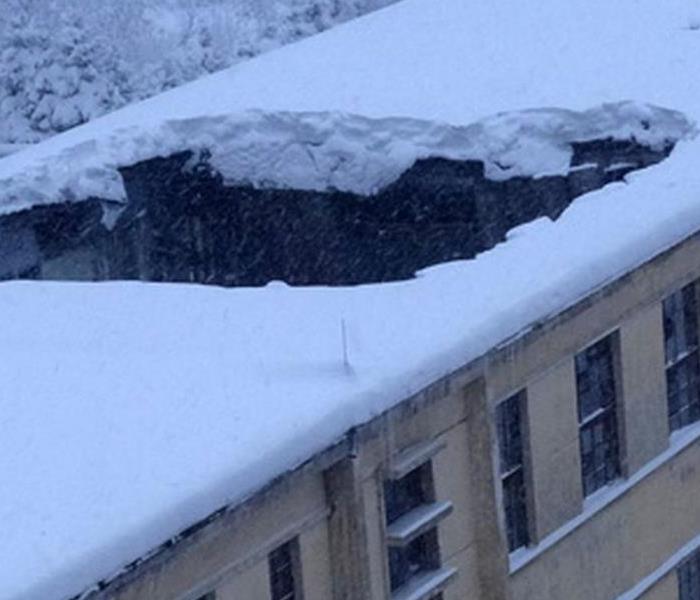 Here is a picture of roof damage caused by heavy snowfall
Here is a picture of roof damage caused by heavy snowfall
Storm damage can be devastating. Because weather is so variable and so unpredictable its important to know beforehand, exactly what kind of damage your home may suffer from a severe storm.
These are some of the most common types of storm damage to your roof, siding, and gutters.
Snow Weighs Down the Roof
Many people are shocked to learn that One of the most common types of storm damage is a damaged rough due to heavy snowfall.
Wind Damages Shingles
Strong winds can blow unsecure shingles off the room of your home AND potentially blow the shingles into a window. We've seen it happen.
Lightning Causes Fires
During thunderstorms, if you're unlucky enough to have your home struck by lightning, your home may catch on fire. This often occurs on rooftops.
Rain Causes Leaks and Damages Granules
If your area experiences excessive rain during one season, you may discover that the constant wetness wears on your roof. Roof shingles may become weaker when they have exposure to such wet weather for a long duration. When paired with other elements, like intense winds, the water can do more damage much faster, especially with leaks.
Rain also damages your shingles by reducing the granules on your roof. Granules help protect your roof and home from the hot rays of the sun, which helps keep your home cool in the summer.
Freezing Weather Causes Ice Dams
Ice dams, which trap water between your roof and a layer of ice, can cause leaking which may then turn into mold and mildew.
Water damage from ice dams isn't uncommon either.
Hail Can Dent and Crack Shingles and Siding
Hail is one of the most damaging elements for your home's roof causing leaks and structural damage at times.
Dealing with storm damage, no matter what it is, is never fun. If you find yourself in the unfortunate place of needing help with storm damage restoration, give SERVPRO of Marlton/Morningside a call at (301) 856-5402.
What to do If You Have a Leak in the Roof of Your Marlton/Morningside Area Home.
6/3/2021 (Permalink)
Roof leaking is a common instance of storm damage. Because leaking roofs don't always seem like imminently dangerous threats to a homes' structure, people tend to wait to get it inspected and fixed.
Listen, it is important to act quickly when it comes to a roof leak. Leaky roofs never fix themselves or get better on their own. Even if the leak isn’t bad yet, get it fixed now.
Sometimes the leak hasn't fully developed yet, and instead the homeowner is noticing some of the pre-signs" of a leaky roof like:
- Musty odors in certain rooms.
- Water stains on your ceiling.
- Spots on your exterior walls.
- Bulging patches on your interior walls.
- Missing or warped shingles.
If this is the case still call a professional for an inspection and consider calling a water and storm damage specialist to assess other damages that may have been caused by the leaking like us here at SERVPRO of Marlton/Morningside at (301) 856-5402.
SERVPRO of Marlton/Morningside ready for any Storms this Spring may Bring!
3/25/2021 (Permalink)
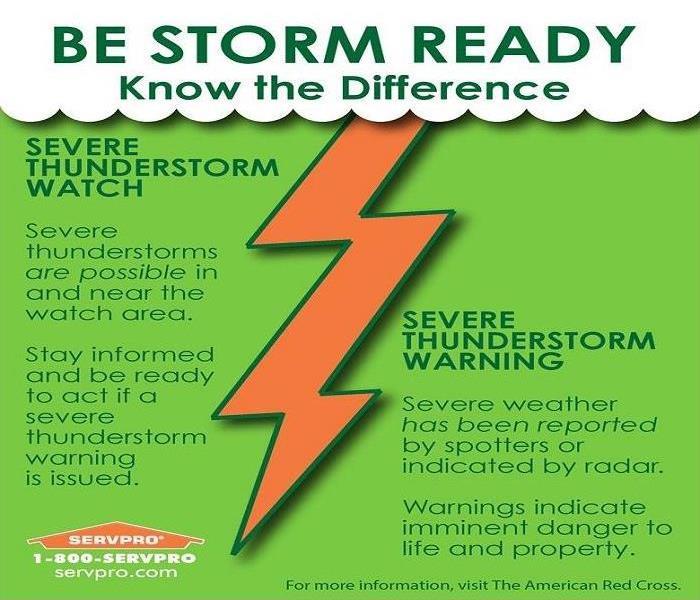 Our highly trained crews are ready to respond 24/7 to storm or flood damage in Marlton/Morningside
Our highly trained crews are ready to respond 24/7 to storm or flood damage in Marlton/Morningside
Strong Spring weather systems bring a variety of hazards to most of the US as they move across the landscape including, Marlton & Morningside, MD. These storm systems are fueled by the collision of cold and warm air masses during Spring.
SERVPRO of Marlton/Morningside specializes in storm and flood damage restoration, and we are prepared to assist you through any downpours any season may bring. Our crews are highly trained and we use specialized equipment to restore your property to its pre-storm condition.
Faster Response
Since we are locally owned and operated, we are able to respond quicker with the right resources, which is extremely important. A fast response lessens the damage, limits further damage, and reduces the restoration cost.
Resources to Handle Floods and Storms
When storms hit Marlton/Morningside, we can scale our resources to handle a large storm or flooding disaster. We can access equipment and personnel from a network of 1,650 Franchises across the country and elite Disaster Recovery Teams that are strategically located throughout the United States.
Have Storm or Flood Damage? Call Us Today (301)856-5402
SERVPRO of Marlton / Morningside Dispatches to Irving, TX to Assist Those Affected by Winter Storm Uri
3/11/2021 (Permalink)
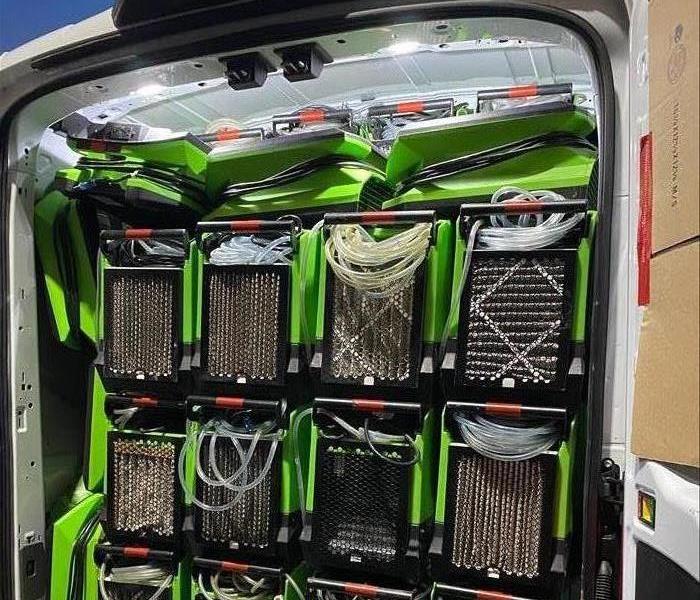 SERVPRO of Marlton / Morningside answered the call when storm Uri threatened the Midwest.
SERVPRO of Marlton / Morningside answered the call when storm Uri threatened the Midwest.
Winter Storm Uri was a major winter and ice storm that affected over 170 million Americans in mid-February 2021.
The storm brought severe destructive weather and caused blackouts for over 9 million people, requiring the need for professional water and extreme weather damage restoration professionals.
SERVPRO of Marlton/Morningside answered the call!
Our brave team members at SERVPRO of Alexandria answered the call by driving for over 24 hours to Irving, TX. Homeowners & business owners alike were faced with unprecedented snowfall while dealing with power outages, frozen pipes, and water damages.
Nationwide Resources to Handle Floods and Storms
When storms hit any part of the US, we can scale our resources to handle a large storm or flooding disaster. We can access equipment and personnel from a network of 1,650 Franchises across the country and elite Disaster Recovery Teams that are strategically located throughout the United States.
Have Storm or Flood Damage? Call Us Today (703)739-2800
4 Types of Flood Waters | SERVPRO of Marlton/Morningside
12/18/2019 (Permalink)
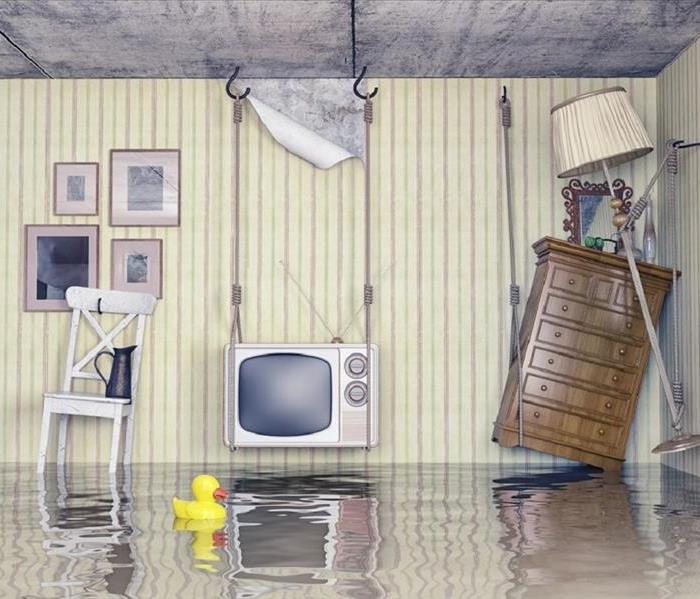 If you experience any storm damage or are in need repairs, contact SERVPRO of Marlton/Morningside
If you experience any storm damage or are in need repairs, contact SERVPRO of Marlton/Morningside
4 Types of Flood Waters
Regardless of where you live, you can be the victim of a flood. Thanks to the damaging effects of water, floods can destroy much of your home and everything inside. If you want to better protect your home from flooding, check out these four common types of flood waters you should be aware of.
- Clean Water Flooding
Sometimes, a faulty pipe or appliance causes flooding inside your house. For example, during the winter, a pipe (containing fresh drinking water) freezes and breaks to create a leak in your basement. This water was designed to be used and consumed by humans, so you don't have to worry about contaminates like sewage.
As long as you catch the damage quickly, this type of flooding can be stopped fast. All you need to do is turn off the water from the source, such as the main water valve. It's still important to remove the water and dry items as fast as possible to prevent mold and mildew, which can cause breathing problems, skin irritation, eye irritation, and other medical issues.
- River Flooding
If an area suddenly receives a lot of rainfall (or a lot of snowfall that melts quickly), it can cause rivers to overflow. Nearby houses, which are normally far from the waters, may find their basements, crawlspaces or entire house filled with river water. Unfortunately, this type of water may be heavily contaminated.
First, many rivers, especially those in urban areas, aren't clean. They contain many pollutants, chemicals, and diseases that can harm you and your family. Similarly, while the water was traveling to your home, it may have caught water pouring from overflowing sewers, which means the flood water may contain fecal matter and similar contaminates. For this reason, especially if there was lots of water damage, many homeowners need extensive repairs to drywall, flooring, and other areas of the home.
- Groundwater Flooding
While much of the Earth's water is on the surface in the form of oceans, lakes, and rivers, there is also a lot of water hiding underground. This groundwater is commonly used for drinking wells, which means it is relatively clean. Plus, as the water is pushed through dirt and rocks, it may shed more contaminates. For this reason, unless the water smells or looks rancid, you can assume that it is mostly clean.
As long as you start cleaning right away, you should be able to restore much of what was exposed to the water. If drywall was impacted, however, you may need to have your walls opened so that they can fully dry. Even if the wall looks dry and clean outside, it may have mold and moisture inside the walls. This is especially a problem if the insulation absorbs water because it can hold the water for a long period of time.
- Sewer Flooding
Sewage can be found in nearly any type of flood water, but flood water can also come directly from the sewer. In some cases, this is simply caused by your toilet or septic system backing up. As a result, the toilet and other drains may begin to let sewage back into your home.
In more severe cases, if lots of flooding causes the sewage system to overflow (or if the system is damaged in some way), it can cause sewage to back up into your home via the toilet. The worst part: this backup is not just your waste; it can be waste from anyone in your community. Sewage like this isn’t just gross; it can cause illness and disease.
Not all flood water is contaminated, but all flood water can lead to major damage and mold growth. If you would like to know more about types of flood waters and damage or if you need to request a quote, contact us at SERVPRO of Marlton/Morningside today.
Storm Damage and Your Home’s Structure
11/18/2019 (Permalink)
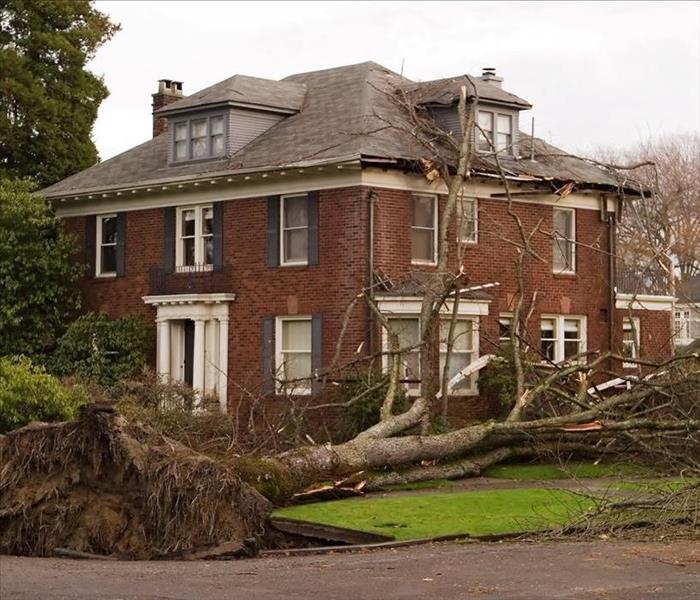 SERVPRO of Marlton/Morningside responds immediately to any storm emergency. We repair your home to its pre-disaster condition.
SERVPRO of Marlton/Morningside responds immediately to any storm emergency. We repair your home to its pre-disaster condition.
Ways a Storm May Damage Your Home's Structural Integrity
One of the reasons why prompt storm damage remediation is so critical is because a storm may damage your home in ways that aren't always obvious. A professional can help you identify and solve any storm damage to the structural portions and other inner workings of your home.
Discover some of the ways a storm could damage your home's structural integrity.
Roof Damage
Your roof can have obvious structural damage if a tree falls on it. However, that's not the only way that a storm could damage the structure of your roof. For example, large tree branches that fall on the roof can also cause damage even though they don't cause an evident cave-in.
Another way a storm can structurally damage your roof is by overloading it with weight. Too much snow can have this effect, especially if it's very wet snow or accompanied by ice.
Foundation Damage
One type of storm damage that can affect your foundation is flooding. Another is erosion. Localized flooding can increase the pressure of water against your foundation wall, which could result in cracks, shifting, sinking, and bowed foundation walls.
Erosion can be more insidious. Rivulets of water from the storm can wash away dirt from around your home's foundation. At first, this may not seem like a big deal, but the ground around your foundation is what holds it in place. And erosion can eventually result in similar types of foundation damage as it allows water more access to your home's foundation.
Interior Water Damage
Whether it enters through a broken window or a roof leak or rises up from the ground, water can be one of the biggest forces of storm damage. Although water may not destroy literally everything it touches, it can come close. Water can cause structural failure in commonly used building materials in your walls, ceilings, and floors.
Drywall can soften once it's been soaked in water and will need replacing. Other building materials such as particleboard may swell up and need replacing as well. Water can also cause plywood to delaminate and make other types of wood crack or split.
Floors, sub-floors, structural beams, rafters, and other significant structural components of your home could be susceptible, depending on what they're made of.
Pest Damage
Although storms don't actually create pests, they can send wildlife looking for places to shelter and can sometimes create damage that allows pests into your home. While most pests are just a nuisance (and sometimes a potential health and safety hazard), some can actually affect your home's structure as well.
Termites may be the most significant example of an insect that causes structural damage. Other wood-destroying insects (typically carpenter ants and powder post beetles) can also cause structural damage to wood components of your home. Prompt storm damage repair can reduce the chances of picking up any of these pests due to storm damage.
Mold Damage
Mold can be a byproduct of storm damage. Because the visible growth of mold exists on the surface of a wall, floor, or other object, homeowners may think of mold as more of a staining problem than a structural problem. But mold has deep-reaching roots that can also eat away at the interior of the object it infests.
Mold uses the organic substances in the wall or other structure as food, so a more severe mold growth may mean a faster deterioration of structural stability. Fortunately, this damage doesn't occur quickly. But mold growth does begin quickly; the EPA recommends remediating any moisture problems in under 48 hours to prevent mold.
As you can see, your home's structure is susceptible to many other types of damage than just large falling objects. For more information on storm damage, how you can prevent storm damage, and what to do if you suspect your home has sustained damage from a recent storm, get in touch with SERVPRO of Marlton/Morningside today.
Storm Damage Prevention and Restoration | SERVPRO of Marlton/Morningside
10/16/2019 (Permalink)
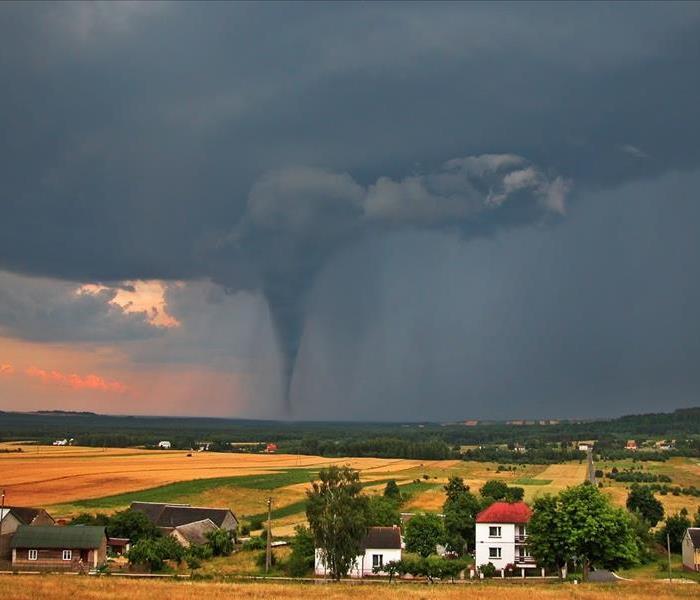 After a devastating storm, contact us as soon as possible. Our job is to repair your home to its pre-disaster condition.
After a devastating storm, contact us as soon as possible. Our job is to repair your home to its pre-disaster condition.
Dealing with a strong storm, such as a severe thunderstorm or tornado, is not easy, but following the right procedures helps keep the damage to a minimum. Naturally, you want to prepare well for any upcoming storm, and of course, you also want to restore your home to its original condition if any damage occurs.
This article looks at how to prepare for strong storms and also examines some key restoration issues.
Preventing Damage From A Storm
One important task for homeowners expecting severe weather to strike their area is to trim back any large tree branches that could potentially fall on their house. In many cases, roof damage from strong storms is the result of large branches falling on the roof and letting rainwater into the home.
Doors and windows often sustain significant damage during strong storms. A good way to keep any damage to a minimum is to cover doors and windows with plywood. If you live in an area where storms are common, it's a good idea to install storm shutters, also known as hurricane shutters.
Do not leave any outdoor furniture outside when a storm is expected. Strong winds can easily lift outdoor chairs and tables and turn them into dangerous flying objects. Put all outdoor furniture in a garage or storage room well in advance of any storm.
Another good idea is to disconnect all of your electronic equipment, such as televisions and computers, before the storm hits. Also, make certain that you know how to turn off your utilities should this become necessary once the storm is over.
Restoring Damage After a Storm
Roofs frequently suffer a significant amount of damage during severe storms. The shingles are often blown off, or tree limbs and other objects create holes in the sheathing. To prevent water from getting into the house through a damaged roof, have a tarp placed over the roof by a professional restoration service, such as SERVPRO.
Also, if you must leave your home after a storm make sure that the doors and windows have been boarded up if you have not done so already. If the storm damaged any boards that you put up in advance, have the damaged boards replaced.
Another vital issue that typically crops up after a major storm is mold remediation. Storms tend to let water into the house, and excessive moisture provides an excellent habitat for mold growth. Mold can gain a foothold in your home in a short period of time, so you must deal with mold problems quickly.
Some mold is not harmful to humans, but other types of mold can cause health problems, so your best course of action is not to deal with the issue yourself. There is no reason to take a chance with your health when experts are available to do the job. Call a qualified restoration firm and have them get rid of the mold.
It's also quite common for important documents to receive damage after a storm due to exposure to moisture. You will want to save your documents if at all possible. Document restoration is not a do-it-yourself job. Fortunately, many storm restoration companies offer document restoring services.
A great way to save damaged documents is to have them freeze-dried. Air-drying damaged documents is another option. The best method usually depends on the amount of damage the documents received.
Preventing storm damage is important, but it's not always possible to prevent a very strong storm from damaging your home or your belongings. If a storm does cause damage to your home or personal property, SERVPRO of Marlton/Morningside can provide vital restoration assistance. Contact us for more information.





 24/7 Emergency Service
24/7 Emergency Service












